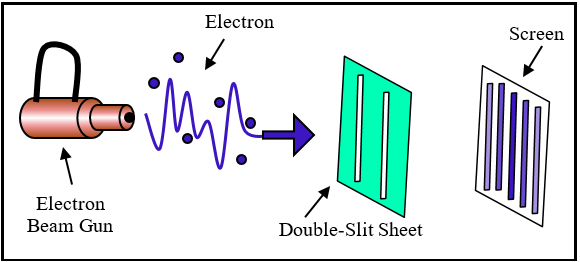I have decided to study quantum mechanics during my free time as this subject interests me alot and I have found some fascinating information I would like to share with you. I came across the term ‘Quantum Mechanics’ while gathering research for another one of my presentations “Is There A Possible Way To Move Faster Than Light?” and ever since, it has captured my interest. I plan to learn about different aspects of this theory and as and when something captivating catches my eye, I would be sure to tell you about it.
~~~~~
Look around you. What can you see? Now what can’t you see?
Quantum Mechanics is the part of physics that study molecules, photons, atoms, subatomic particles etc. using microscopes and other scientific instruments. In quantum mechanics, atoms are described as waves, but when measured, they are seen as particles. This has created the mathematical dilemma called ‘the measurement problem’. Figure A shows a well known experiment called “the double slit experiment”. By looking at it you can therefore see that this experiment proves that atoms can be in wave form. If they couldn’t, there would only end up being 2 lines on the screen. Moving on to the ‘measurement problem’. The measurement problem refers to the fact that we humans still don’t know how atoms go from being in a wave state to a particle state (also known as particle-wave duality).

Consequently, particle-wave duality can lead to a phenomenon known as quantum entanglement. When two electron waves collide with each other, they become connected. Then, no matter how far they go – even if it is a billion miles away – they will still have a connection. It works like this. If you have an entangled atom, then it will have an infinite spin until you measure it. Say you measure it and it has an upward spin. You will then immediately know that the one it is entangled with has a downward spin. This theory confused even one of the greatest mathematicians – Albert Einstein – since it suggested faster than light communication. View Figure B for a visual representation. Quantum Entanglement truly is outstanding and fascinating.

Furthermore, we can use quantum mechanics for interesting equipment such as atomic clocks, uncrackable codes, super powerful computers, improved microscopes and biological compasses. Scientists are also trying new things to see how we can use quantum entanglement in our day to day lives. The more we know about quantum mechanics and quantum entanglement, the more questions we have since it is such a complex and interesting topic. After all, as physicist Neils Bohr wisely said – “If quantum mechanics hasn’t profoundly shocked you, you haven’t really understood it.”



Thanks!